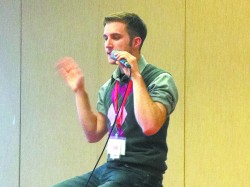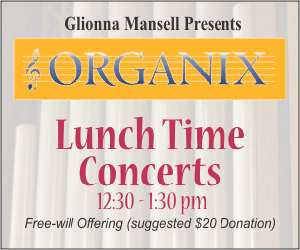So why is it that a cappella singing feels less intimidating than singing in a choir?
 AARON JENSEN, artistic director of SING!:When many people hear the phrase “a cappella” they think Glee — visions of spirited high school students recklessly brandishing “jazz hands” (or the even more saccharine, “spirit fingers”) and belting out triadic auto-tuned harmonies with bravado — but the term has much older roots. “A cappella,” literally meaning “in the manner of the chapel,” refers to all vocal music performed with no instrumental accompaniment. This umbrella term covers the music of countless styles, genres and cultural backgrounds.
AARON JENSEN, artistic director of SING!:When many people hear the phrase “a cappella” they think Glee — visions of spirited high school students recklessly brandishing “jazz hands” (or the even more saccharine, “spirit fingers”) and belting out triadic auto-tuned harmonies with bravado — but the term has much older roots. “A cappella,” literally meaning “in the manner of the chapel,” refers to all vocal music performed with no instrumental accompaniment. This umbrella term covers the music of countless styles, genres and cultural backgrounds.
Even though SING! is an a cappella festival, we’ve branded ourselves as a “vocal arts” festival to best represent this diversity. Under our roof, patrons can hear all manner of a cappella including: classical choral groups, vocal jazzers, gospel choirs, world ensembles, live-looping artists, pop vocal bands, barbershop quartets, collegiate glee-clubbers, vocal improv collectives and even a cappella comedy troupes.
So does a festival like SING! help to bridge the gulf (if there is one) between solo and choral singing? What’s in it for people coming from a more formal (if that’s the right word) choral background? And on the other hand, for bathtub divas what does it say about the potential joys of showering with a few friends?
Whether you get your vocal kicks in the confines of your shower, or flanked by a legion of professionally trained choristers, the common ground is one and the same: the joy of singing. I strongly believe that all people have the ability — and every right — to express themselves as part of a vocal community, regardless of their musical background.
In addition to SING!’s eclectic performance mandate it is of utmost importance to us that we provide our community with the opportunity and permission to sing in a safe and welcoming environment. The festival is dedicated to exploring the possibilities of the human voice and taking anyone along on the ride, from the most accomplished vocal virtuosos to the humblest tavern bellowers.
Say a bit about your From Sea to Sea song cycle project: conception, hurdles along the way
and “final” shape (if anything ever is really final).
From Sea to Sea has been in the works for close to four years now. In 2008, I hatched the idea to compose a major choral song cycle that featured a vocal setting of one poem per province and territory of Canada — “From sea to sea” (Canada’s national motto). Ever since then, I have been pouring through countless volumes of Canadian poetry (which has been a true pleasure), chasing down publishers, lawyers and copyright holders (which has been less so), and composing.
Who are your poets?
I finally settled on a mix ranging from such beloved historic figures as Robert Service and Lucy Maud Montgomery, to contemporary innovators such as Gwendolyn MacEwen, Christian Bök and Shane Koyczan. My goal has been to compose a series of pieces every bit as diverse as the country that inspired them. Composing it has taken me into a real hodgepodge of subjects: overtone singing, the braille alphabet, traditional bodhrán jig patterns and so forth. The final song cycle includes everything from contemporary classical choral pieces to lively folk melodies, from minimalistic soundscapes to rhythmic, jazz-informed harmonic works.
When during SING! is the premiere?
Sunday, May 12 at 2:30pm, proudly featuring the Elora Festival Singers, the Elmer Iseler Singers, Cawthra Park Chamber Choir, Countermeasure, the SING! Singers featuring Denzal Sinclaire, and our host, Marilyn Lightstone.
How did the marriage with Harbourfront come about? What would you say are the biggest pros and cons?
Like so many marriages, our courtship was fast and furious. The SING! board officially formed in the fall of 2011, and we had the lofty ambition to put on a large-scale festival by early spring (only six months later). We really lucked into our partnership with Harbourfront Centre. Our mandate lined up beautifully with theirs, and our artistic vision lent itself to the sort of programming that they’re renowned for. With us being the new kid on the block, their stamp of approval gave our festival a certain legitimacy from day one. Their team provided us (and continues to provide us) with an incredible amount of behind-the-scenes support.
And the not so perfect, if there’s anything?
Though laudable, Harbourfront Centre’s 80% free programming mandate has proved an interesting challenge. To meet this 80% quota, and at the same time program the number of ticketed concerts and workshops necessary to keep the festival afloat, has meant scheduling over 100 events over the festival’s four-day run. It’s a challenge we have gladly taken in stride.
You were still with Cadence at the time of the first SING!, right? What’s different now in terms of goals and pursuits?
I had actually given my notice to Cadence around the time that the SING! board was first forming. I would say that my goals and pursuits have remained relatively consistent since then — I’ve just granted myself the time and space to actualize a larger number of them. I tend to be happiest when I have several artistic pots in the fire ... several pots in the artistic fire?... At the moment I am recording, gigging and touring with three vocal groups: Countermeasure, a 15-voice vocal band that I co-founded three years ago; Retrocity, a 1980s a cappella pop octet; and The Watch, a new quartet that will be representing Canada at Serenade! Washington, DC Choral Festival this coming July. I will be releasing a solo album in December, a project that’s been in the works for the past several years, and I continue to busy myself with ongoing new commissions and musical director/clinician work.
How much of your life does SING! consume and why is it worth it?
Developing the SING! festival has been a full-time volunteer position from the beginning. I truly believe in this project and am supported by a tireless board of directors who share the same vision and drive. It has been a labour of love and I feel that I’ve every reason to feel optimistic about our prospects. It is no small accomplishment for a large-scale festival to break even in its first year. We’ve received tremendous support and investment from some of the foremost choirs and vocal groups (both locally and internationally) and the message that keeps coming back is that there is huge (and ever-growing) interest in what we’re offering. SING! is working with a ten-year business model and artistic vision. Vocal music is flourishing in Toronto, and we plan on leading the singing revolution.
—interview by David Perlman
The SING! Toronto Vocal Arts Festival takes place at Harbourfront Centre, May 9 to 12.



